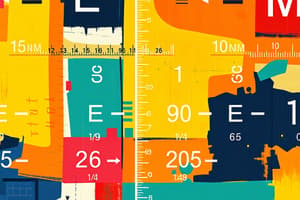Podcast
Questions and Answers
What is the unit of magnetic flux in the cgs system?
What is the unit of magnetic flux in the cgs system?
- Tesla
- Gauss (correct)
- Newton
- Ampere
What is the unit of temperature in the SI system?
What is the unit of temperature in the SI system?
- Fahrenheit
- Kelvin (correct)
- Rankine
- Degree Celsius
What is the symbol for the metric prefix representing 10^-15?
What is the symbol for the metric prefix representing 10^-15?
- nano
- micro
- pico
- femto (correct)
What is the full form of 'mks' units?
What is the full form of 'mks' units?
What is the purpose of metric prefixes?
What is the purpose of metric prefixes?
What is the unit of length in the cgs system?
What is the unit of length in the cgs system?
Why is the mks system preferred in scientific and engineering work?
Why is the mks system preferred in scientific and engineering work?
What is the value of the metric prefix 'femto'?
What is the value of the metric prefix 'femto'?
What is the symbol for the metric prefix representing 10^3?
What is the symbol for the metric prefix representing 10^3?
Why are some units from the cgs system still in common use?
Why are some units from the cgs system still in common use?
Flashcards are hidden until you start studying
Study Notes
Quantities and Units
- The metric prefix mega has replaced 10^6.
Metric Prefixes
- Metric prefixes represent powers of ten in engineering notation.
- Table 3 lists metric prefixes with their symbols, powers of ten, and values.
Examples of Conversion
- 50,000 V = 50 * 10^3 V = 50 kV
- 25,000,000 Æ = 25 * 10^6 Æ = 25 MÆ
- 0.000036 A = 36 * 10^-6 A = 36 µA
Converting between Units with Metric Prefixes
- To convert from a larger unit to a smaller unit, move the decimal point to the right.
- To convert from a smaller unit to a larger unit, move the decimal point to the left.
- Determine the number of places to move the decimal point by finding the difference in the powers of ten of the units being converted.
Examples of Metric Unit Conversions
- 0.15 milliampere (0.15 mA) = 0.15 * 10^-3 A = 150 * 10^-6 A = 150 µA
- 4500 microvolts (4500 mV) = 4500 * 10^-6 V = 4.5 * 10^-3 V = 4.5 mV
- 5000 nanoamperes (5000 nA) = 5000 * 10^-9 A = 5 * 10^-6 A = 5 µA
- 47,000 picofarads (47,000 pF) = 47,000 * 10^-12 F = 0.047 * 10^-6 F = 0.047 µF
- 0.00022 microfarad (0.00022 mF) = 0.00022 * 10^-6 F = 220 * 10^-12 F = 220 pF
- 1800 kilohms (1800 kÆ) = 1800 * 10^3 Æ = 1.8 * 10^6 Æ = 1.8 MÆ
History of Metric Units
- In 1954, the basic SI units (meter, kilogram, second, ampere, kelvin, and candela) were adopted by international agreement.
- The mks (meter-kilogram-second) units are used for derived quantities and are the preferred units for nearly all scientific and engineering work.
- The cgs system, based on the centimeter, gram, and second, is an older metric system that is still in use in some areas.
Studying That Suits You
Use AI to generate personalized quizzes and flashcards to suit your learning preferences.




